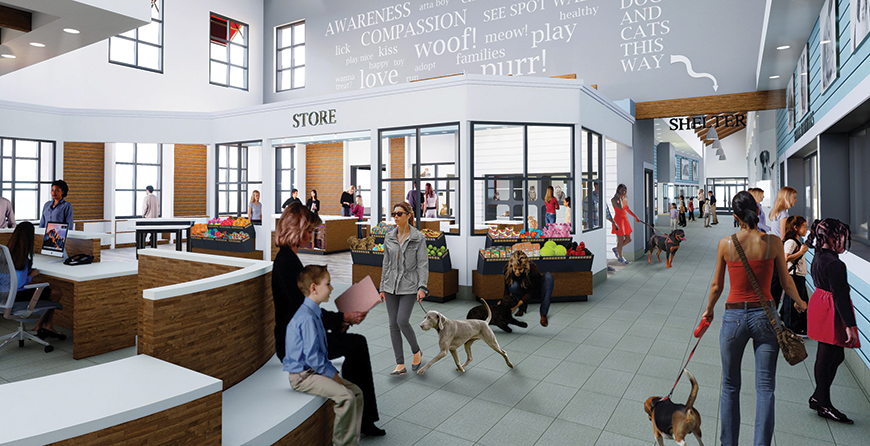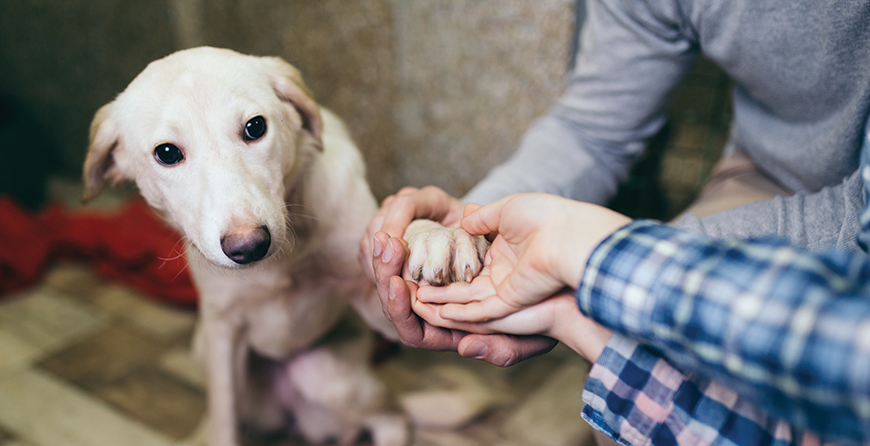The seeds of the Idaho Humane Society (IHS) were planted about 119 years ago when a group of animal loving activists in Boise took on the task of pushing for more humane treatment of farm livestock, working animals, and dogs that roamed freely through the streets of Boise. They set in writing their goals, “to provide effective means for the prevention of cruelty to animals throughout the state of Idaho.”
Fighting for Humane Treatment
Even as they fought for the humane treatment of animals, the group did not own or operate an animal shelter. That changed in 1941, when the organization began sheltering stray dogs after their volunteers discovered the deplorable conditions of the existing “Boise dog pound,” a three-sided wooden barn on the banks of the Boise River where dogs were warehoused, starved, or killed. The group took over the facility, cleaned it up by hauling pails of water from the Boise River, installed cement floors and electric lights, and instituted policies to be more humane toward the animals.
In 1949 the group moved its operations to an abandoned Army barracks near Gowen Field, and, in 1959, they built their first dedicated animal shelter. Fast forward to 1997; the current shelter was built, again near Gowen Field, still hidden on the outskirts of the Boise Airport.
“Back then it wasn’t unusual to want animal shelters out of sight and out of mind,” said Dr. Jeff Rosenthal, DVM, chief executive officer of the IHS since 2000. “They wanted them out at the sewage plant, the dump or the airport, like where we are. But, that’s no longer the case. Today, an animal shelter is a positive place where some great things are happening.”

A rendering of the planned lobby of the Idaho Humane Society’s new facility. Rendering courtesy CSHQA.
More Than Just A New Shelter
One of the “great things” happening for Idaho’s largest animal rescue organization is its new 42,000-square-foot facility opening in June on a 10-acre site on Overland Road between Cole and Maple Grove Roads. The IHS “Designed to be Kind” capital campaign has been raising funds for the facility since 2011.
When the $15 million shelter opens, it will be double the size of the current shelter and will serve as much more than just a place for lost or abandoned animals. Rather, it will house an advanced veterinary medical center with a teaching hospital, adoption center, humane education center where youth can interact with and learn about animals, acres of outdoor walking and play areas, and a public dog park. Plus, to Rosenthal’s delight, it will no longer to be hidden away off the beaten path behind the airport.
The dog kennels will be more like small rooms with only five enclosures per area versus the 26 kennels per area the shelter now has. There are also large get-acquainted areas, a training pavilion and indoor playrooms. Plus, the cattery is larger and offers enclosed outdoor “catios” and cat colony rooms with room to play and roam.
“There’s nothing that takes the place of a home for these animals, and it won’t be a home, but it’ll closer to it,” Rosenthal said.
An environmentally friendly “green” building, the facility has state-of-the-art technology designed to decrease noise, smells, and, ultimately, the stress on animals that are sheltered there. “Creating an animal shelter is like nothing else,” Rosenthal said, noting that everything from the sanitary air venting system to acoustics and plumbing is designed specifically for shelter and veterinary operations.
Saving the Unadoptable
For several years, the IHS has been the destination for dogs and cats from overcrowded, high kill-shelters in other states. The animals are flown in by volunteer organizations such as Dog Is My Co-Pilot and Wings of Rescue, both of which are operated by private pilots who transport the animals at
no charge.
“We take the surplus dogs that are going to be euthanized [at other shelters],” said Rosenthal. “So in every one of these flights we have a number that require a lot of extra care from us. Some of these dogs will be with us a long time, and because we have great medical and behavioral resources, I see it as something we need to do to help these other communities.”
About 12,000 animals are taken into the shelter each year. “We handle about the same number of animals as the Oregon Humane Society in Portland and more animals than Seattle and Spokane. We have amazing medical capabilities that just a handful of animal shelters around the country have, and we also have behavioral resources that most shelters don’t have.”
Helping ‘Problem Dogs’
As far as behavioral work, Rosenthal said its IDAPI program, or Inmate Dog Alliance Project of Idaho, is a successful training and socialization program for dogs that have behavioral issues. “We house the dogs in prison cells with inmates for an average of six weeks of socialization and behavior training,” said Rosenthal. He added that the inmates are trained to work with the dogs, and the dogs come out much more adoptable.
For kitties there is WISKR, or Women Inmate Social Kitty Retreat, which houses cats with respiratory problems with women in the correctional facility who care for them until they’re well. “The women basically give them love and medicine so they have time to heal,” said Rosenthal. “All they need is just a few weeks of TLC.”
Teaching Youth Compassion
Today’s IHS still follows its founders’ mission of teaching humane animal treatment. “We know the key to a better tomorrow is to focus on kids,” said Rosenthal. “It involves a lot more than just responsible pet care; it’s also about inspiring kids to be interested in an animal’s welfare and what they need to be happy. That lesson can also translate to general empathy and compassion toward other people.
“In our humane education, we talk about bullying and being civil, integrating how dogs interact with each other and approach sensitive issues that also apply to people, such as how dogs come in all shapes and sizes and colors and how they all treat each other like any other dog,” said Rosenthal. “So there are things we try to integrate to help kids be good human beings.”
Good Samaritans and Volunteers
Rosenthal recalled the many times when people have stopped to pick up injured and lost animals, put them in their vehicles and brought them to the shelter. “There are Good Samaritans caring for bedraggled, rain soaked muddy dogs and cats that they pick up on the side of the road and put in their brand new Lexus and have their upholstery destroyed, just to save a life,” Rosenthal noted. “We have an army of unpaid volunteers that descend on us every day to help. This place is inspiring, just seeing people doing the right thing.
“Sometimes when I tell people I work at the shelter they say, ‘Oh I could never work there, it would be too sad, and I love animals too much to work in a place like that.’ My thought is that our employees and volunteers love animals so much that they wouldn’t want to work anywhere else.”
Insights from Dr. Jeff Rosenthal, DVM
“The most prevalent dog at the Idaho Humane Society is a Chihuahua or Chihuahua mix. I would have never predicted that in Boise, Idaho. For years and years it was the Labrador retriever that we saw the most, of course. Then it was the pit bull terrier, which is now third. Those numbers are going down, finally.”
“There was a time when every third or fourth dog in the shelter was a border collie. Since agriculture in the area has decreased we don’t see those herding breeds as much.”
“We have a large explosion of rabbits coming in. Rabbits are typically not the greatest pet for a kid. They don’t even like to be hugged. A rabbit can live 10 or 12 years, so when you get your child a rabbit at age 12, are they really going to be taking care of it when they’re 24?
“Small mammals are probably the most abused companion animals in the country. They are not given the space or the habitats they require for their welfare, and a lot of them end up in our shelter.”
“IHS works on a sliding scale based on income. And, we are donation supported, meaning we receive no government funding.”
“When I came here in 2000 we had 48 employees and now we have 115. We’ve have had to expand into trailers.”
The IHS spays and neuters about 9,000 animals per year. The focus of its public hospital is for people who don’t have the resources to provide emergency care for their pets. For many low-income people in that position, euthanasia is often the only choice. Most euthanasia in veterinary hospitals is due to financial need, not that the animal couldn’t be treated
or saved.

